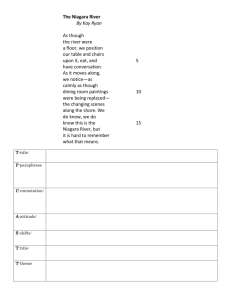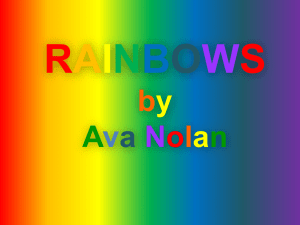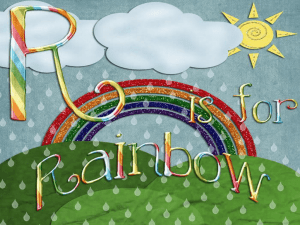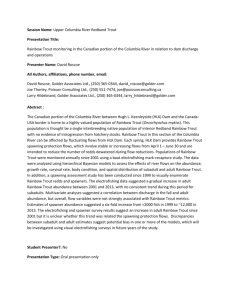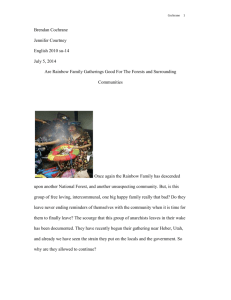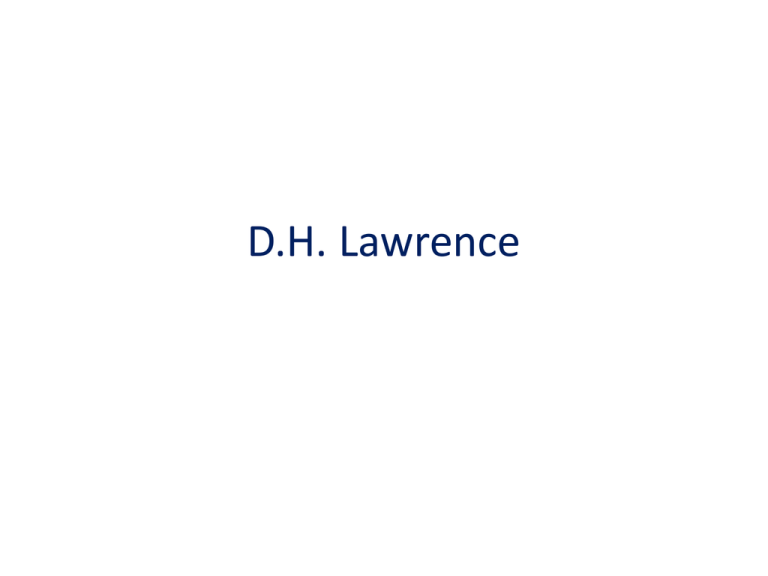
D.H. Lawrence
Brinsley Colliery
Nottinghamshire
Lawrence’s Wedding (1913)
Cornwall
The Rainbow
I. The “nonhuman” in The Rainbow
II. Lawrence and the representation of
consciousness
III. Marriage and modern individuality
The Brangwens
Ur -Brangwens
Pages 9-13: “The Brangwens had lived for generations on Marsh Farm…” (Ur-Brangwens)
Tom’s Parents
Pages 14-16: “The Alfred Brangwen of this period” and his wife…
1: Tom and Lydia
Ch.1 ["How Tom Brangwen Married a Polish Lady“]
Ch 2 ["They Live at the Marsh"]
2: Will and Anna
Chapter 3 ["Childhood of Anna Lensky"]
Chapter 4 ["Girlhood of Anna Brangwen"]
Chapter 5 ["Wedding at the Marsh"]
Chapter 6 ["Anna Victrix"]
Chapter 7 [“The Cathedral”]
3: Ursula
Chapter 8 [“The Child”] - Chapter 16 [“The Rainbow”]
Ursula and Gudrun in love
Women in Love
“[There] is a constant revelation in Hardy’s
novels: that there exists a great background,
vital and vivid, which matters more than the
people who move upon it.”
Study of Thomas Hardy (1914)
“The young corn waved and was silken, and
the luster slid along the limbs of the men
who saw it. They took the udder of the cows,
the cows yielded milk and pulse against the
hands of the men, the pulse of the blood of
the teats of the cows beat into the pulse of
the hands of the men.”
(10)
“And then it came upon him that
he would marry her and she would be
his life.
Gradually, even without seeing
her, he came to know her.
(39)
The Rainbow
I. The “nonhuman” in The Rainbow
II. Lawrence and the representation of
consciousness
III. Marriage and modern individuality
“And then it came upon him that he
would marry her and she would be his life.
Gradually, even without seeing her, he
came to know her.”
(TR, 39)
“He did not think of anything, only knew
that the wind was blowing.”
(41)
“The geese trailed away with
uplifted heads under the low grey sky.
‘They don’t know you,’ said
Brangwen. ‘You should tell `em what your
name is.’”
(66)
“So there you have the ‘serious’ novel, dying in
a very long-drawn-out fourteen-volume death
agony, and absorbedly, childishly interested in
the phenomenon. ‘Did I feel a twinge in my little
toe, or didn't I?’ asks every character in Mr.
Joyce or Miss Richardson or Monsieur Proust. ‘Is
the odour of my perspiration a blend of
frankincense and orange pekoe and bootblacking, or is it myrrh and bacon-fat and
Shetland tweed?’”
“Surgery for the Novel– or a Bomb” (1923)
I’m sure it’s the burgundy. Yes. One,
two. […]
Pprrpffrrppffff.
Done.
Ulysses, 11.1290-1294
Methods of Representing Consciousness in The Rainbow
1. Psycho-Narration (“He did not think of anything, only knew
that the wind was blowing.”)
Psycho-Analogy
2. Dramatization
Compression
Posture
The drama of the face
Psycho-Analogy
“Within himself his will was coiled like a beast,
hidden under the darkness, but always potent,
working.”
(171)
Methods of Representing Consciousness in The Rainbow
1. Psycho-Narration (“He did not think of anything, only knew
that the wind was blowing.”)
Psycho-Analogy
2. Dramatization
Compression
Posture
The drama of the face
Dramatization: Posture
• “He turned away indoors, humbly. There was the infinite world,
eternal, unchanging, as well as the world of life.” (77)
• “She turned away, hearing only the sharp hiss of his mingling
corn.” (114)
• “She turned indoors so that he should not see her tears.” (143)
• “She realized that her life, her freedom, was sinking under the
silent grip of his physical will. […] Then she turned fiercely on
him, and fought him.” (172)
Dramatization: Face
• “Was this what she had to come to hear: how by doing this
thing and by not doing that, she could save her soul? She did
not contradict it. But the pathos of her face gave the lie.”
(147)
• “A strained light came into his eyes, he had a slight knitting of
the brows.” (21)
• “A tormented look came into his eyes, as though something
were always dogging him.” (62)
The Rainbow
I. The “nonhuman” in The Rainbow
II. Lawrence and the representation of
consciousness
III. Marriage and modern individuality
“And always she was gone before he came. As he
came, she drew away, as he drew away, she
came. Were they never to meet? Gradually, a low,
deep-sounding will in him vibrated to her, tried to
set her in accord, tried to bring her gradually to
him, to a meeting, till they should be together, till
they should meet together as the sheaves that
swished together.”
(114-115)
“He loved the undiscovered and the
undiscoverable. He pored over the pictures
intensely […] How undiscovered the world was,
how it revealed itself to his soul! What a fine,
exciting thing his life was, at his hand! Did not
Bamberg Cathedral make the world his own?”
(153)
Lincoln Cathedral
“All the moonlight upon her, all the darkness
within her! [Remember the image of Africa we
get in Conrad as huge and dark.] All the night in
his arms, darkness and shine, he possessed of it
all! All the night for him now, to unfold, to
venture within, all the mystery to be entered, all
the discovery to be made.”
(116)
“Within himself his will was coiled like a beast,
hidden under the darkness, but always potent,
working. ”
(171)
“Adam and Eve fell, not because they had sex, but
because they became aware of their sex. When sex
became to them a mental object-- that is, when they
discovered that they could deliberately enter upon
and enjoy and even provoke sexual activity in
themselves, then they were cursed and cast out of
Eden. Then man became self-responsible; he entered
on his own career.”
Psychoanalysis and the Unconscious (1920)
“Sex is the fountain head, where life bubbles up
into the person from the unknown.”
(1913)
“And he seemed to live thus in contact with her,
in contact with the unknown, the unaccountable
and incalculable”
(58)
“And each time he returned home, he went
steadily, expectantly, like a man who goes to a
profound, unknown satisfaction.”
(57)
“[H]e, satisfied, moved with a proud, insolent
slouch of the body … unaware of her, ignoring her
very existence after taking his fill of her and
getting his satisfaction of her.”
(151)
“To know is human, and in death we do not
know, we are not human.”
(Women in Love, 191)
“You must not say my novel is shaky-- It is not perfect,
because I am not expert in what I want to do. But it is
the real thing, say what you like. And I shall get my
reception, if not now, then before long. Again I say, don’t
look for the development of the novel to follow the lines
of certain characters: the characters fall into the form of
some other rhythmic form, like when one draws a
fiddle-bow across a fine tray delicately sanded, the sand
takes lines unknown.”
Chladni Figures
“Strange, to lift the stamp and see that eaglebeaked bird raising its breast to her. She loved
creating it over and over again. And every time
she looked, it seemed a new thing come to life.
Every piece of butter became this strange, vital
emblem.”
(109)
“Dawn and sunset were the feet of the rainbow
that spanned the day, and she saw the hope, the
promise. Why should she travel any further?”
(181)


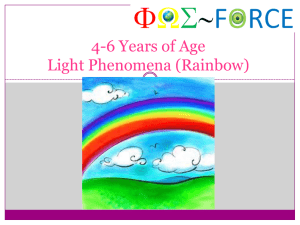

![Rainbow Sandals[1]](http://s2.studylib.net/store/data/005415944_1-86d746c06518ebd8de8a03e56a4931b4-300x300.png)
